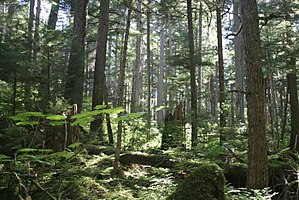 The Tongass National Forest, located in Alaska, is one of our nation’s last true unspoiled regions. The forest, to the surprise of many, is actually a rainforest, home to ancient trees, vast populations of wildlife and an amazing ecosystem. Currently, the government is considering dropping protections for the watersheds and wildlife in this gorgeous forest.
The Tongass National Forest, located in Alaska, is one of our nation’s last true unspoiled regions. The forest, to the surprise of many, is actually a rainforest, home to ancient trees, vast populations of wildlife and an amazing ecosystem. Currently, the government is considering dropping protections for the watersheds and wildlife in this gorgeous forest.
Covering over 192 million acres, the forests in our nation are home to threatened and endangered species of wildlife. They also provide clean drinking water for the American population. Current legislation is in the works to rescind protection against logging and road development through our nation’s forests, including the Tongass National Forest. But why should you care?
People
The Tongass National Forest is home to over 70,000 people who depend on the land for the sheer livelihoods. Native tribes like the Tlingit, Tsimshian and Haida inhabit the forests, comprising some 31 communities. Juneau, the state’s capital, is, itself, located in the national forest.
Animals
Several species of animal that are rarely found outside of Alaska’s borders thrive in this region. Among these are Bald eagles, black and brown bear and five distinct species of salmon. With logging and road construction comes destruction of valuable habitat and, in turn, the endangerment of these species.
Wilderness
The forest is home to 19 areas of designated wilderness. These include Kootznoowoo Wilderness, Russell Fjord Wilderness, Coronation Island Wilderness and Maurille Island Wilderness. These wilderness areas cover over five million acres of land that are designated for protection by four separate land management agencies.
Recreational Opportunities
In 1962, the Mendenhall Glacier Visitor Center became the first visitor center built by the US Forest Service in the nation. 150 public cabins and 15 campgrounds are spread throughout the forest offering amazing views of the surrounding wilderness and amazing setting.
Hundreds of thousands of people visit the region each year to take advantage of the opportunity to see things they won’t see anywhere else in the United States. Visitors enjoy sightings of Bald eagles and black bears from viewing platforms located throughout the forest.
Logging
With all of the advantages that the region presents to the people of the United States, why is there a push to open it up to logging? Unfortunately, because the government is under the mistaken belief that the region can supply much of the nation’s timber for the building and construction industries.
The reality is that much of the wood in the Tongass National Forest is low in value to the building industry. Because the majority of timber in Tongass is considered low-value, ages old trees have been over-harvested throughout the region. In reality, there is no need to log in the region when timber value is low and there are efficient mills found throughout the United States and Canada.
What the government needs to consider, when discussing current legislative action, is that the forest contributes more than $2 million to local economies, as is, each year. Thanks to recreation, food and scientific use, local economies have come to depend on the region for their sustainability.
We urge everyone to research the Tongass National Forest and all that it provides. After you have done so, write letters, send emails or call your representatives and voice your opposition to removing logging restrictions in our national forests.
Brady Olson is a conservation writer for savebiogems.org, a division of the National Resources Defense Council, which has mobilized to save the Tongass National Forest. This area is at risk from the impending removal of critical protections for wildlife and watersheds in the world’s largest remaining temperate rainforest.
 Alternative Energy HQ solar power for homes, wind energy, and bio fuel issues
Alternative Energy HQ solar power for homes, wind energy, and bio fuel issues






